Japandi living rooms represent the perfect fusion of Japanese minimalism and Scandinavian warmth, creating spaces that prioritize both serenity and functionality. This design philosophy emphasizes natural materials, neutral color palettes, and clean lines while maintaining a cozy, livable atmosphere. The style combines the minimalist and functional aesthetic of Scandinavian design with the traditional and natural elements of Japanese design, creating a harmonious and peaceful space that is both functional and beautiful. These twenty carefully curated ideas will help you transform your living room into a tranquil sanctuary that embodies the best of both design traditions.
1. Low-Profile Japandi Living Room Sofas
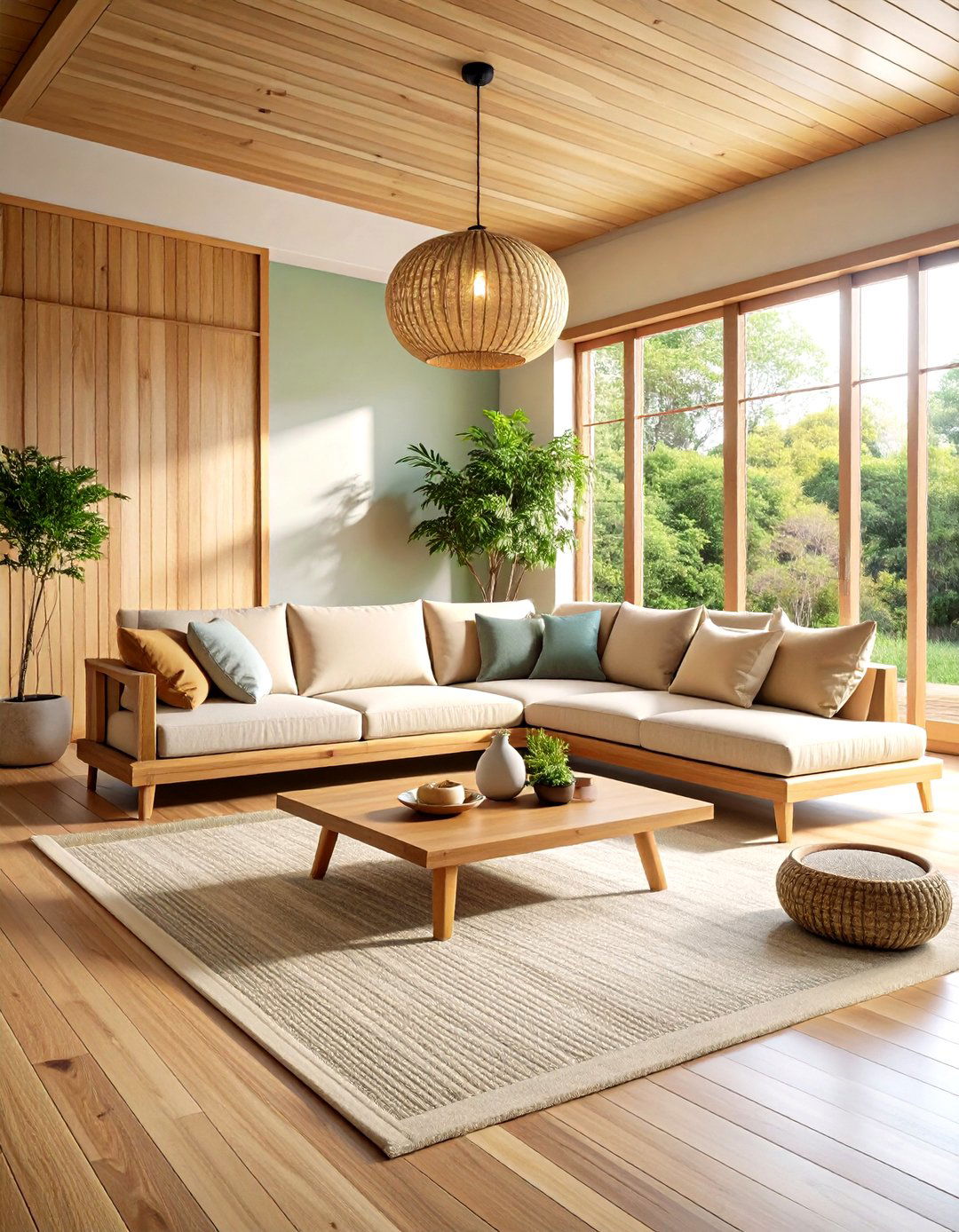
Low-profile wooden sofas with simple cushions or sleek Scandinavian armchairs made from natural wood represent ideal Japandi furniture choices. These seating pieces emphasize clean lines and organic shapes while maintaining comfort and functionality. Choose sofas with minimal ornamentation, focusing on quality craftsmanship and sustainable materials like oak or walnut. The low-profile design creates an open, airy feeling that's essential to Japandi aesthetics. Neutral upholstery in linen or cotton adds texture without overwhelming the space. These pieces serve as anchoring elements that ground the room while promoting relaxation and mindful living.
2. Japandi Living Room Wood Slat Wall Features

Wood slat walls, perfect as accent walls, comprise single, muted colors and clean lines that make head-turning statements without overpowering the space. These architectural elements add texture and visual interest while maintaining the minimalist aesthetic central to Japandi design. Consider using light-toned woods like oak or pine for a Scandinavian influence, or darker woods for Japanese-inspired depth. The vertical lines create height and structure, while the natural wood brings warmth and organic beauty. These features work particularly well behind televisions or as focal walls, providing both aesthetic appeal and practical mounting solutions for modern living room needs.
3. Japandi Living Room Natural Lighting Solutions
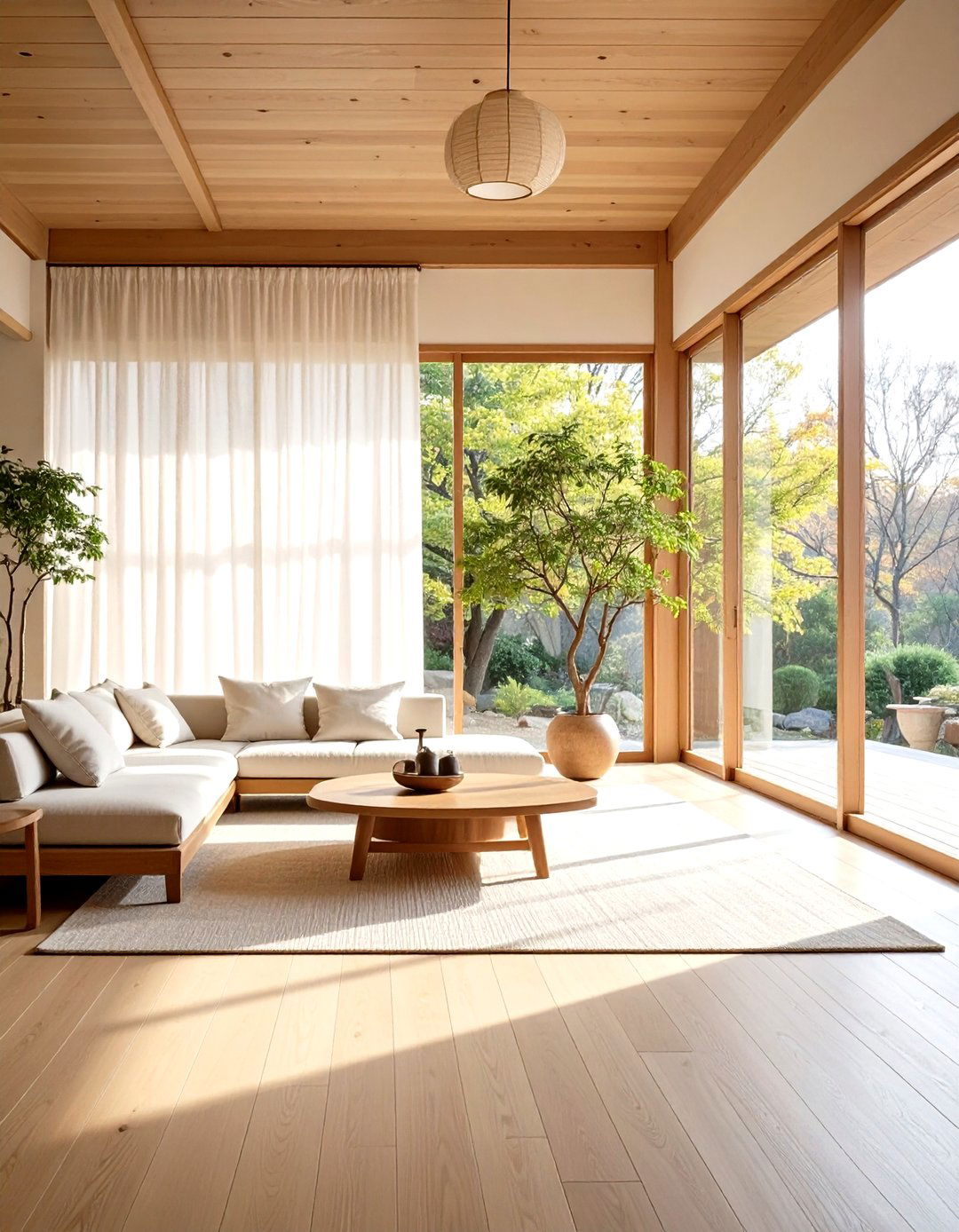
Natural light plays a crucial role in Japandi living rooms, aligning with the design's focus on harmony and well-being, with increased natural light offering many benefits. Maximize daylight through minimal window treatments or sheer curtains that filter sunlight gently. This approach strengthens the connection to outdoors, fundamental to both design philosophies. Large windows or glazed walls create perfect solutions for Japandi spaces. Consider replacing heavy drapes with light-colored blinds or removing window coverings entirely when privacy permits. The goal is creating bright, airy environments that celebrate the changing qualities of natural light throughout the day, enhancing the room's serene atmosphere.
4. Japandi Living Room Neutral Color Palettes
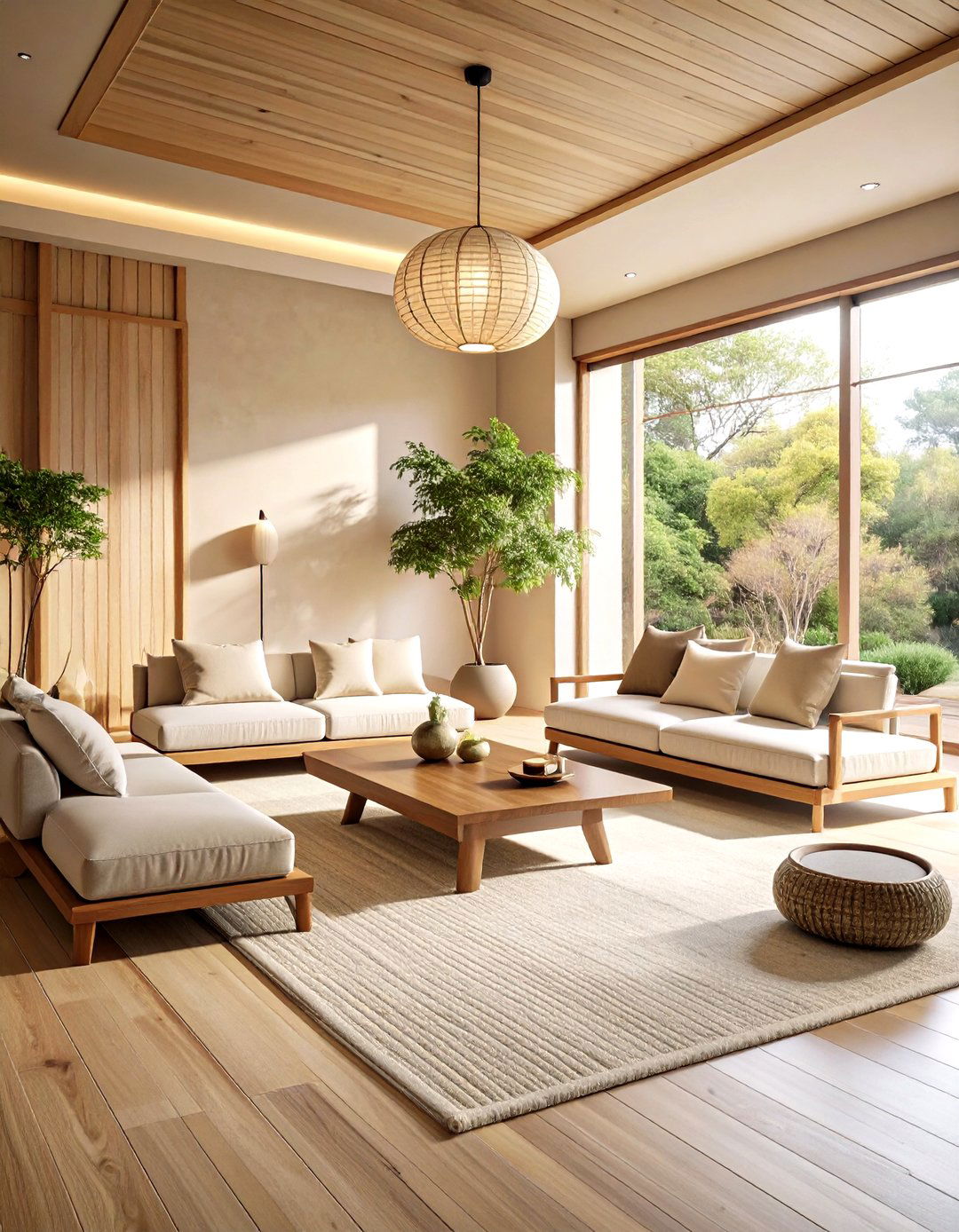
Japandi style centers on creating serene minimalist spaces through neutral color palettes consisting of muted tones like beige, taupe, oatmeal, and stone. These understated colors create calming backdrops while allowing natural light to enhance the space. Start with warm whites or light grays for walls, then layer in deeper neutrals through furniture and accessories. The palette can include soft pastels or subtle earth tones for variation without disrupting the harmonious feel. Black accents provide contrast and definition, while maintaining the overall sense of tranquility. This restrained approach to color supports the mindful, uncluttered aesthetic that defines successful Japandi interiors.
5. Japandi Living Room Shoji Screen Room Dividers
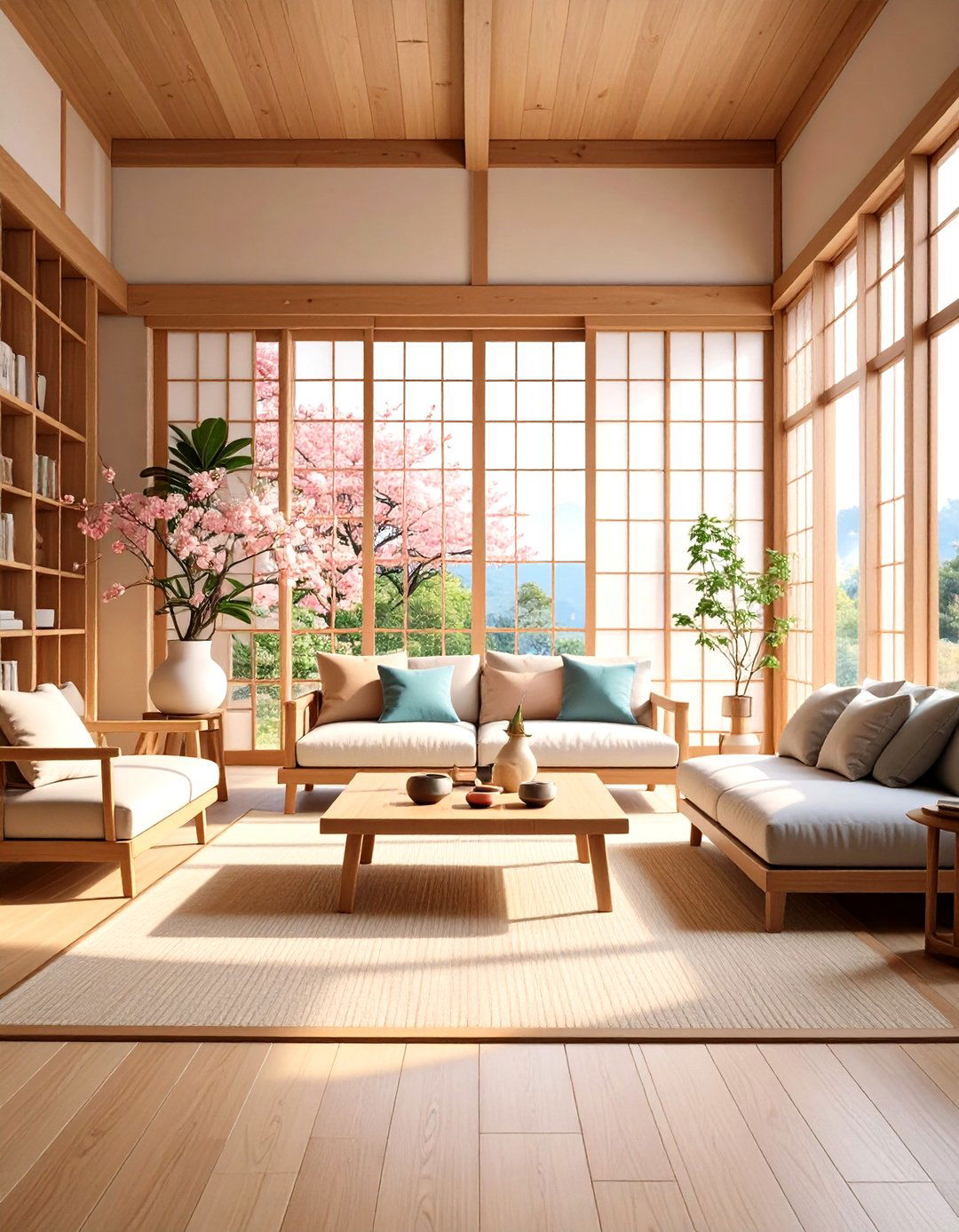
Traditional Japanese shoji screens create separation between living rooms and other areas while maintaining cohesive design aesthetics and adding visual interest. These translucent panels filter light beautifully while providing flexible space division in open floor plans. Choose screens with natural wood frames and rice paper or fabric panels for authentic appeal. They can separate dining areas from living spaces or create intimate reading nooks within larger rooms. The screens' geometric patterns add subtle visual texture while maintaining the clean lines essential to Japandi design. Their mobility allows for changing room configurations based on daily needs, supporting the functional aspect of this design philosophy.
6. Japandi Living Room Handmade Ceramic Décor
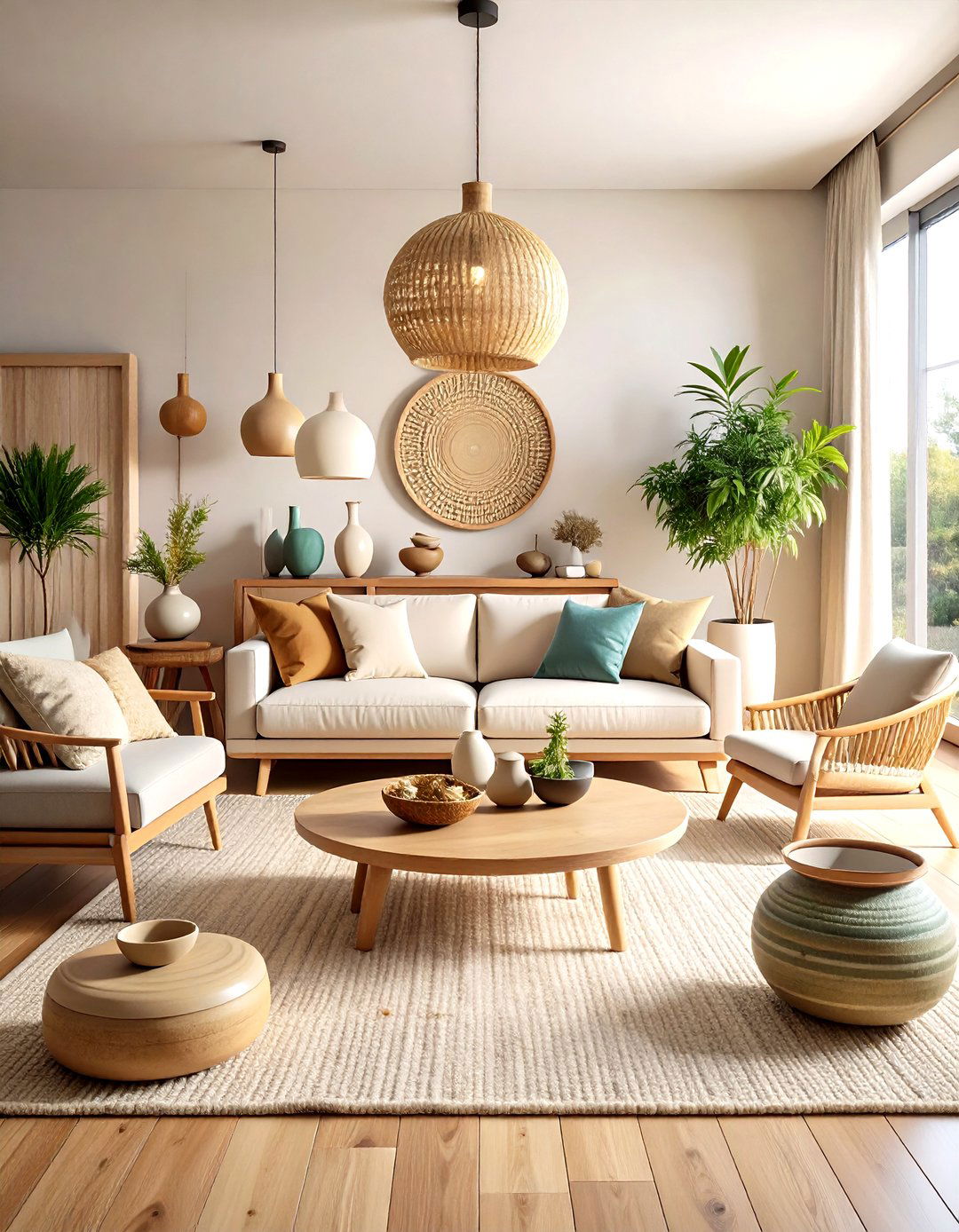
Beautifully made ceramic pieces are staples in Japandi design, with handmade ceramics, imperfect pottery, or vintage objects adding character and authenticity to spaces. These elements highlight the beauty of imperfection, reflecting the Japanese wabi-sabi philosophy. Select ceramic vases, bowls, or sculptural pieces in neutral tones that complement your color palette. The handcrafted quality brings warmth and human connection to minimalist spaces. Choose pieces with subtle irregularities or weathered patinas that tell stories and add visual interest. These decorative elements should be purposefully placed rather than scattered, with each piece contributing to the overall sense of harmony and thoughtful curation that defines Japandi interiors.
7. Japandi Living Room Tatami Mat Flooring
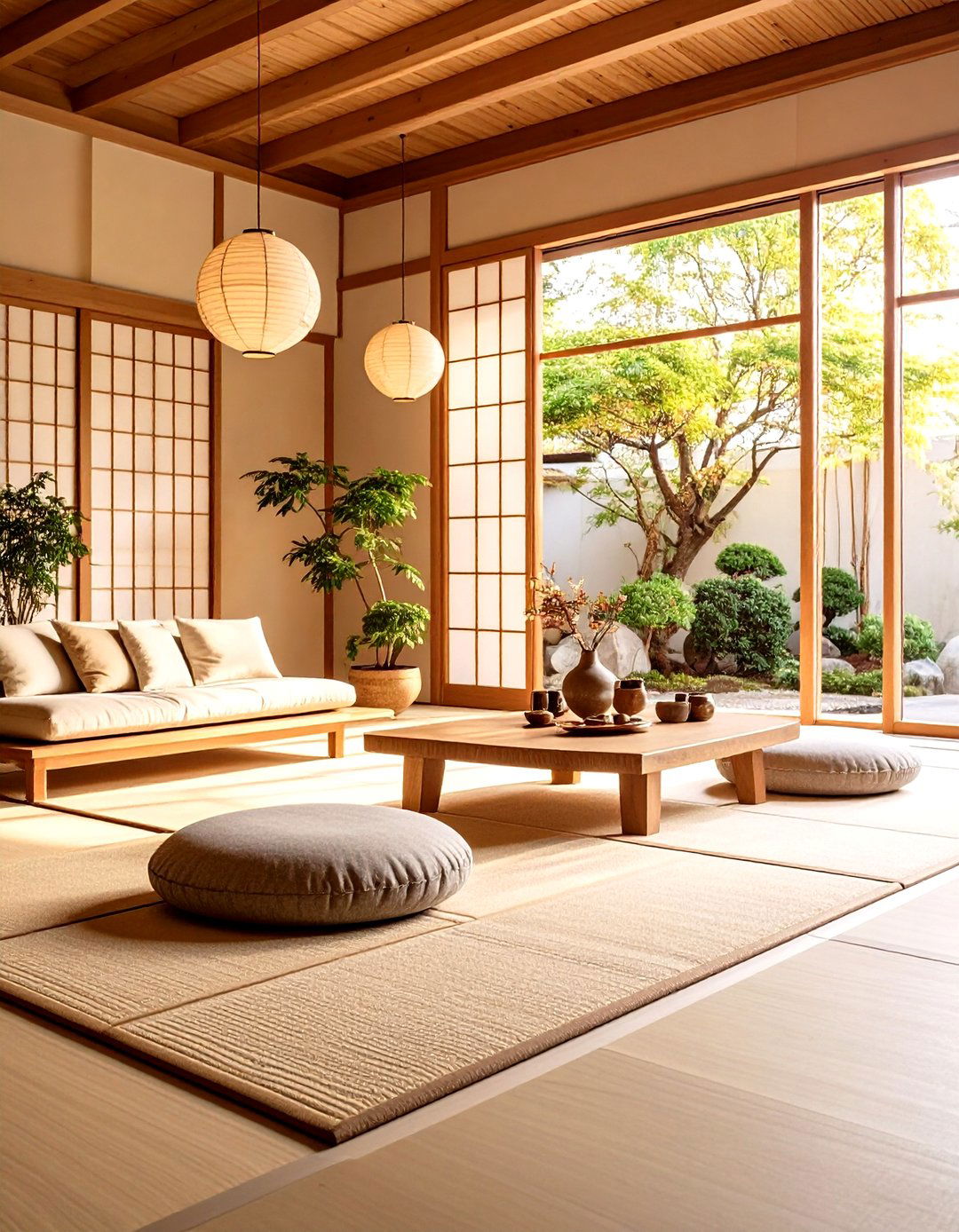
Traditional Japanese tatami mats add authentic touches to Japandi living rooms and are comfortable to walk on, easy to handle, slip and stain resistant. These natural floor coverings bring texture and cultural authenticity while providing comfortable surfaces for floor seating arrangements. Modern tatami options work well as area rugs or can cover entire sections of flooring. They're ideal for creating meditation spaces or casual seating areas within larger rooms. The natural materials align with Japandi's emphasis on organic elements, while their modular nature supports flexible furniture arrangements. Choose neutral colors like beige or natural brown to maintain the cohesive color palette while adding subtle texture and warmth to hard flooring surfaces.
8. Japandi Living Room Pendant Light Fixtures
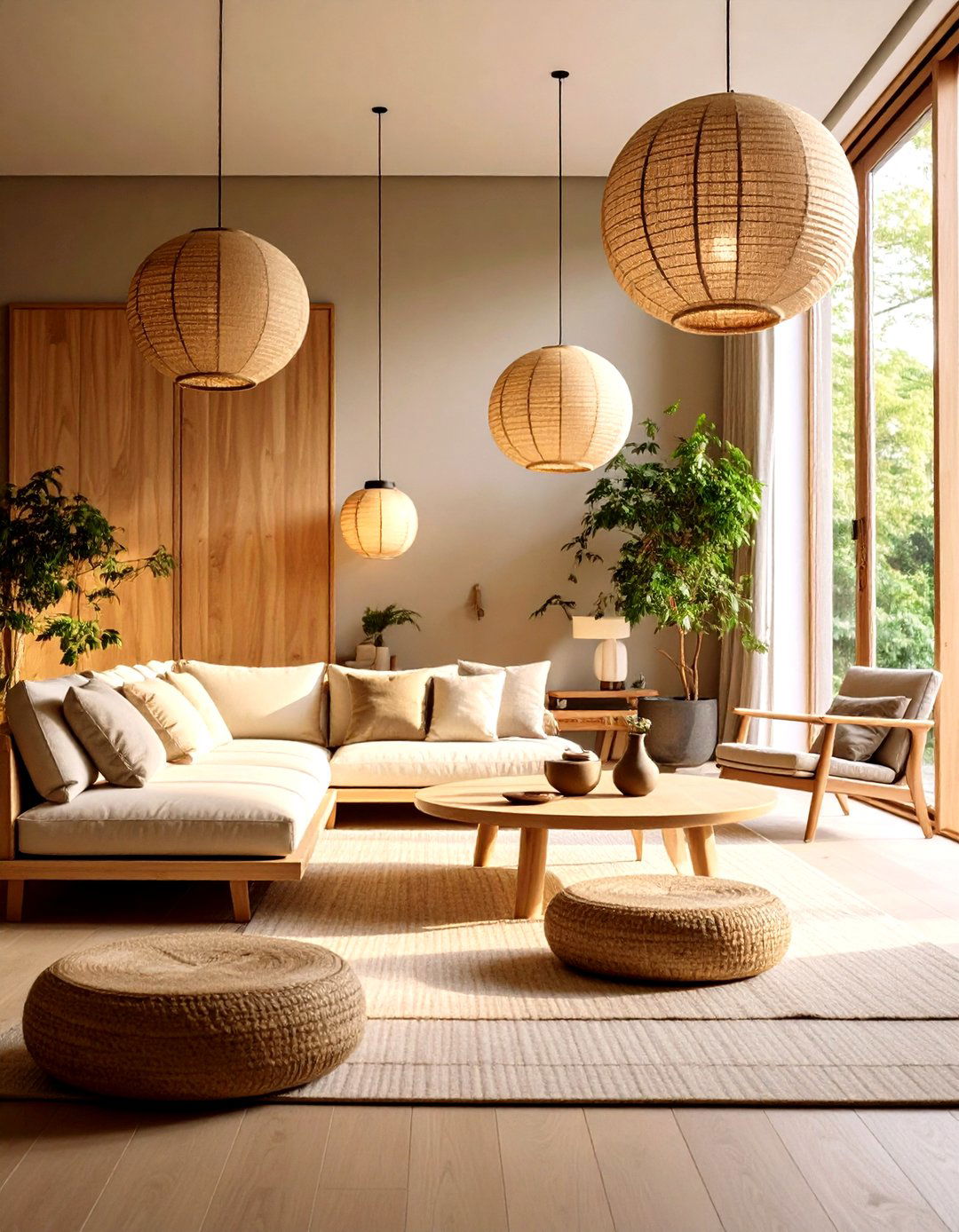
Pendant lights with warm-toned shades serve as excellent centerpieces while maintaining Japandi aesthetics, featuring sleek designs and natural materials that create calming ambiances. Select fixtures made from bamboo, paper, wood, or rattan that complement the natural material palette. These lights should feature simple, geometric forms without excessive ornamentation. Consider clustered arrangements over dining areas or single statement pieces above coffee tables. The warm lighting they provide supports the cozy atmosphere essential to Japandi design. Choose adjustable heights to accommodate different ceiling levels and room proportions. LED bulbs with warm color temperatures enhance the fixtures' natural materials while supporting sustainable living practices central to both design philosophies.
9. Japandi Living Room Natural Fiber Rugs
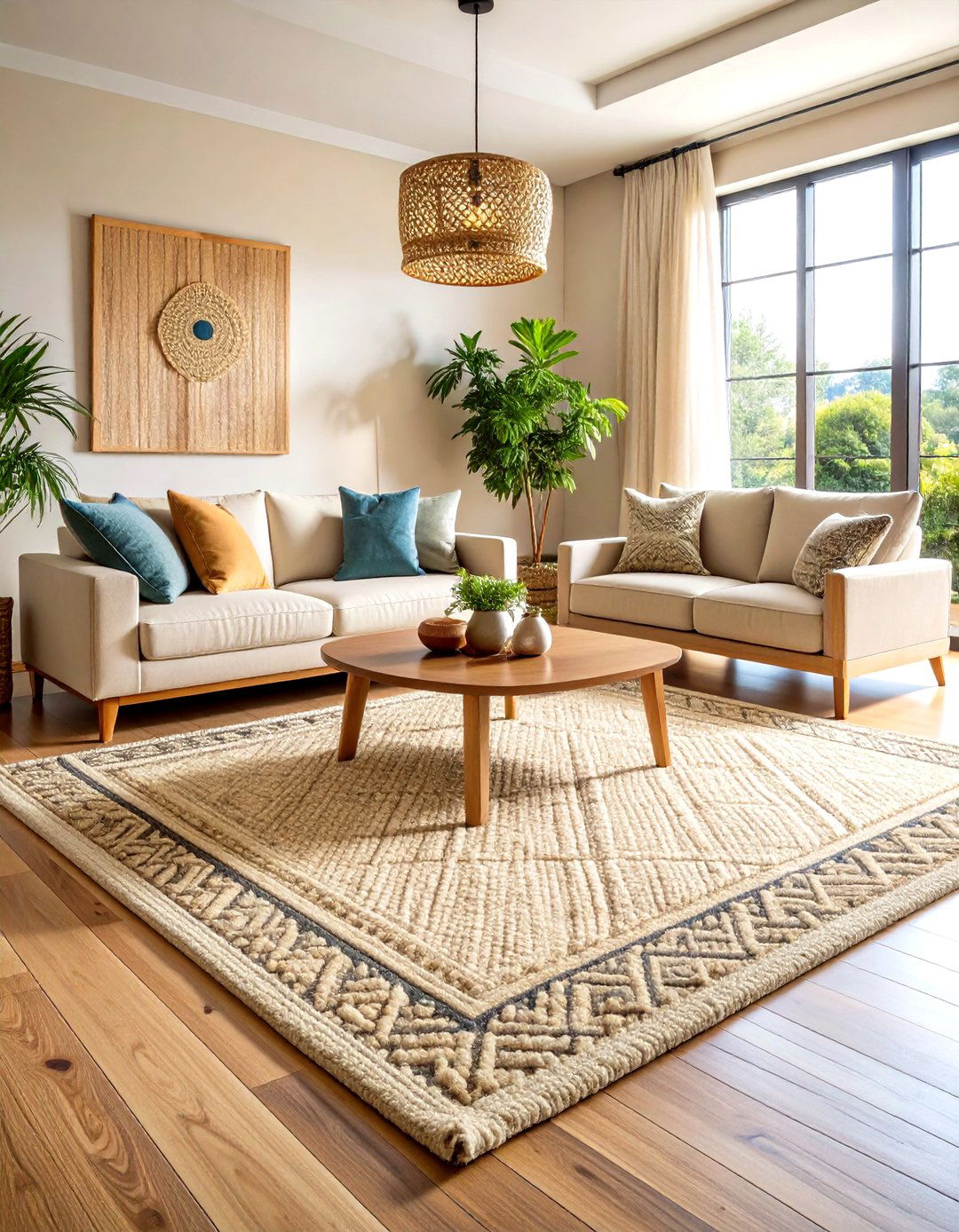
Natural fibers such as wool, cotton, linen, or jute are preferred over synthetic materials, providing texture and depth while promoting sustainability. These rugs should feature simple geometric patterns or solid colors that complement rather than compete with other room elements. Large rugs that sit under main furniture pieces create illusions of wider, more integrated spaces while minimizing visual clutter. Choose neutral tones like soft beige, muted grays, or gentle browns that align with the overall color palette. The natural textures add tactile appeal without overwhelming minimalist aesthetics. Consider layering different textures and sizes for added depth while maintaining the cohesive, uncluttered feel essential to successful Japandi interiors.
10. Japandi Living Room Minimalist Storage Solutions

Storage units with cupboards and drawers allow items to be packed away, maintaining practical, open spaces that flow well without compromising minimalist aesthetics. Choose pieces with clean lines and hidden storage compartments that serve multiple purposes. Wooden cabinets with simple hardware blend seamlessly into the overall design while providing necessary organization. Built-in solutions work particularly well, creating custom storage that doesn't interrupt the room's flow. Consider benches with internal storage, coffee tables with shelving, or ottomans that open for storage. These functional pieces support the "less is more" philosophy by keeping clutter out of sight while maintaining the serene, organized atmosphere that defines Japandi living spaces.
11. Japandi Living Room Boucle Texture Seating
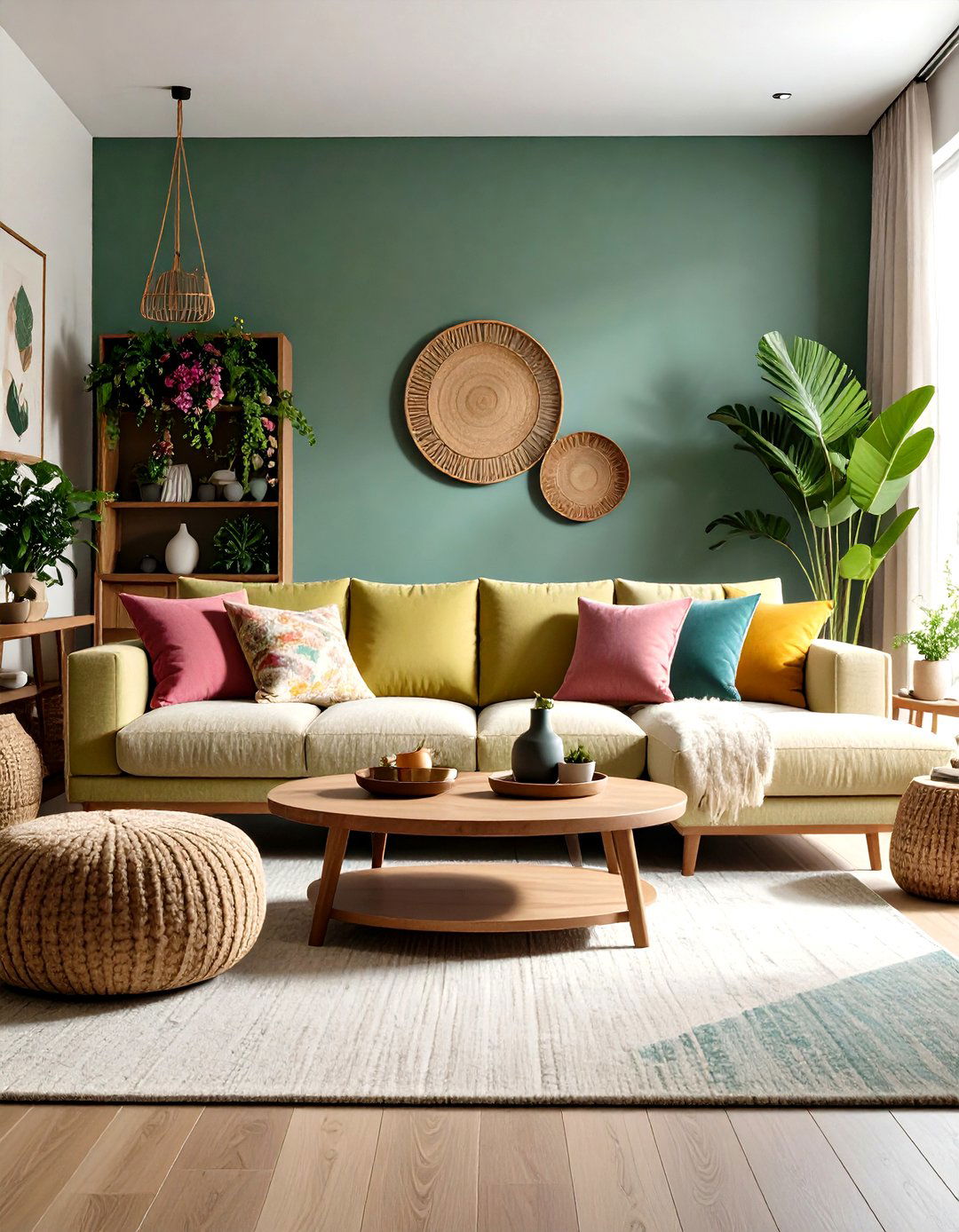
Boucle sectionals and seating furniture add textural interest and comfort while maintaining the neutral color palette essential to Japandi design. This nubby, soft textile brings Scandinavian coziness into minimalist Japanese-inspired spaces. Choose pieces in cream, oatmeal, or soft gray tones that integrate seamlessly with the neutral palette. The texture adds visual and tactile warmth without disrupting the clean aesthetic. Boucle's organic, imperfect texture aligns with wabi-sabi principles while providing the comfort and coziness associated with Scandinavian hygge. These pieces work particularly well as accent chairs or sectional components, adding sophisticated texture while maintaining the functionality and comfort essential to livable Japandi interiors.
12. Japandi Living Room Wall Sconce Lighting

Japandi wall sconces feature clean lines and natural materials, creating warm ambiances while taking up minimal wall space compared to other lighting fixtures. These fixtures provide layered lighting essential to creating depth and dimension in minimalist spaces. Choose sconces with simple, geometric forms made from wood, metal, or paper materials. Position them strategically to highlight artwork, architectural features, or create reading areas. The soft, diffused light they provide supports the calming atmosphere central to Japandi design. Consider using warm-colored LED bulbs or even candles for inviting glows perfect for relaxation. Wall sconces offer flexibility in lighting schemes while maintaining the uncluttered aesthetic that defines this design philosophy.
13. Japandi Living Room Mixed Material Furniture
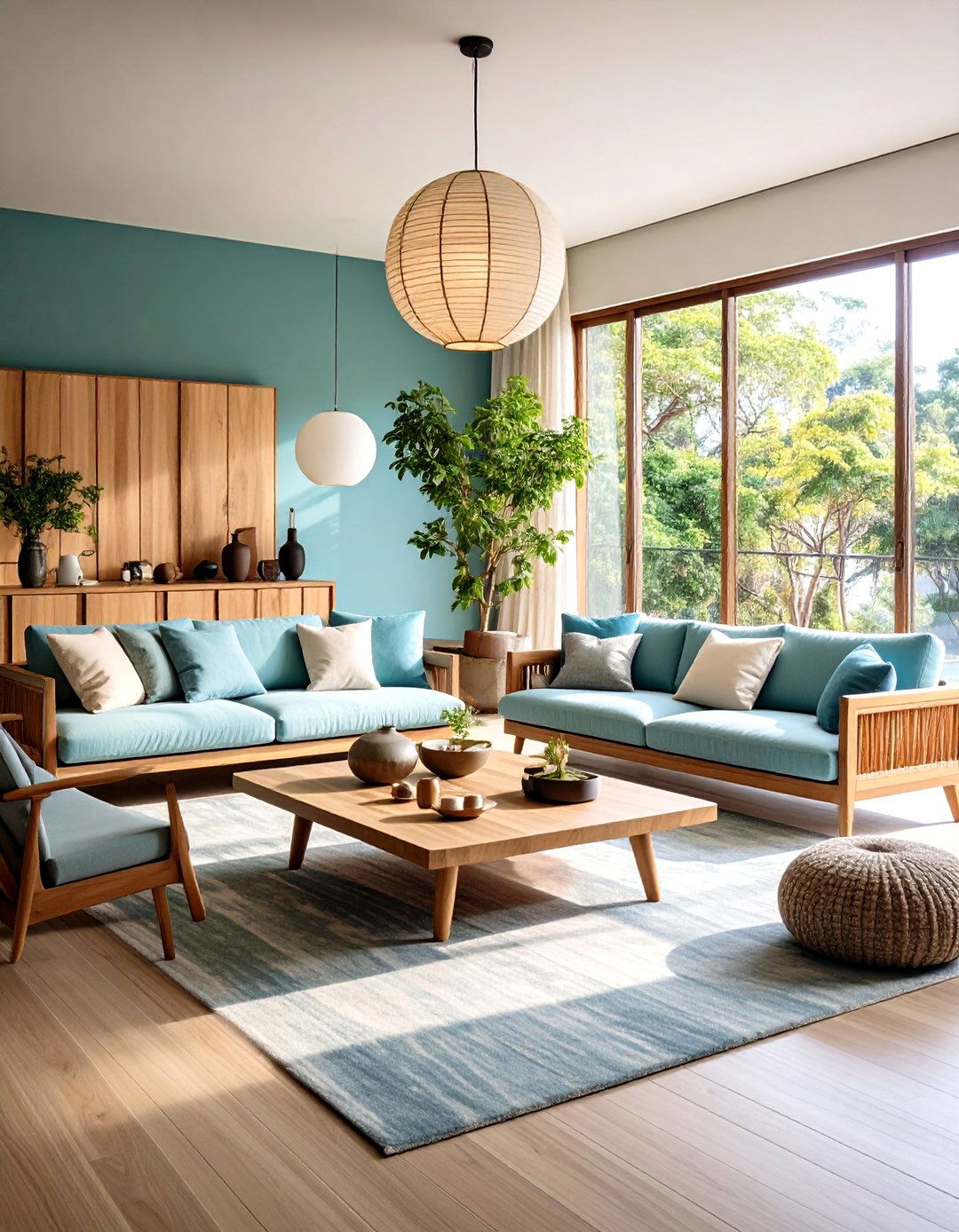
Japandi design encourages mixing different furniture styles and materials like wood, metal, and glass to create unique, eclectic looks while adding visual interest and texture. Combine pieces that share common design principles but vary in materials and forms. For example, pair wooden coffee tables with metal accent pieces or glass surfaces with natural stone elements. The key is maintaining harmony through shared color palettes and proportions rather than exact matching. This approach prevents spaces from feeling too uniform while celebrating the craftsmanship and beauty of different materials. Each piece should feel intentionally chosen and contribute to the overall sense of balance that defines successful Japandi interiors.
14. Japandi Living Room Natural Wood Coffee Tables
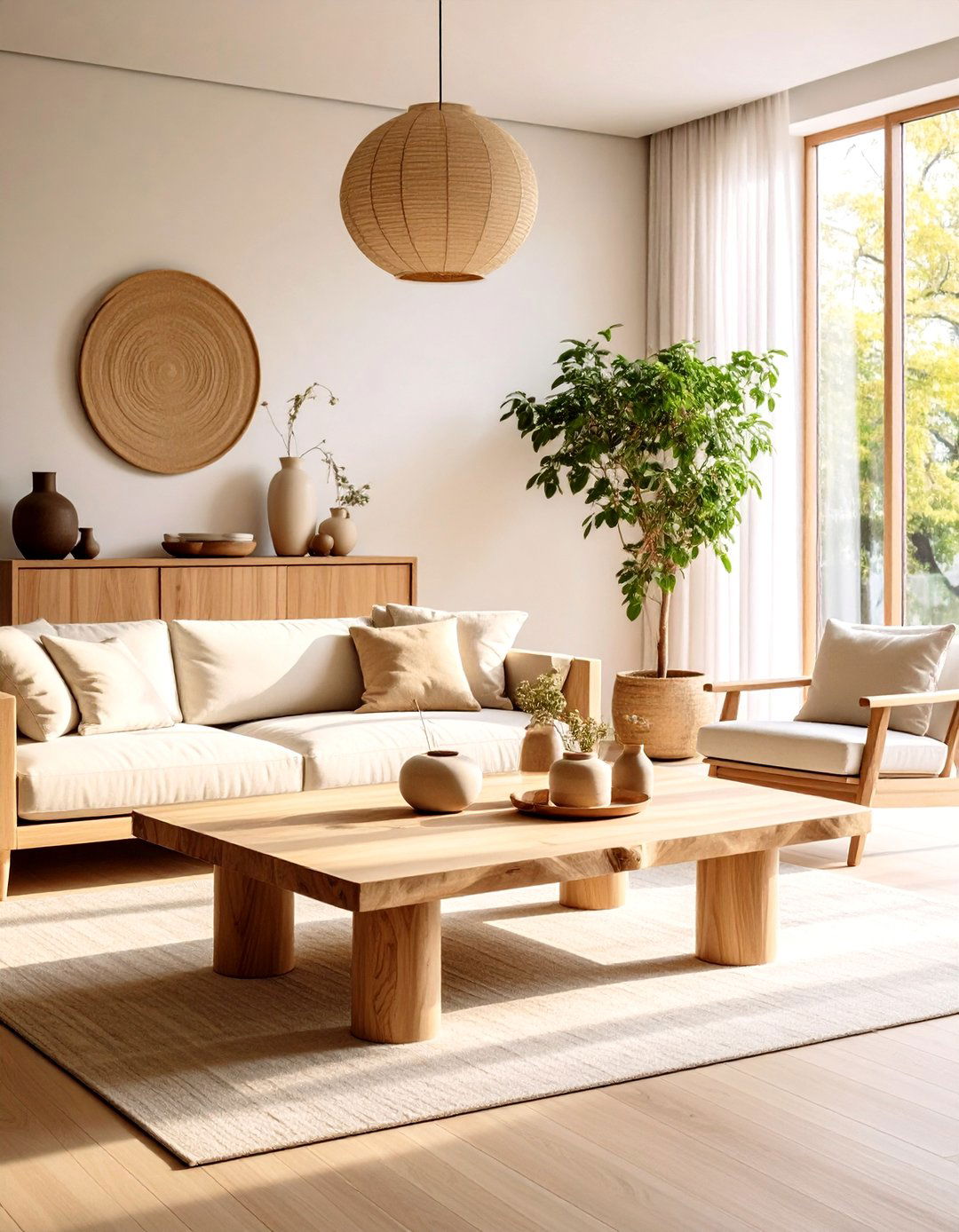
Light-colored wood coffee tables create natural, warm feels in living rooms while serving as sleek, functional centerpieces that maintain minimalist aesthetics. Choose pieces with clean lines and minimal ornamentation that showcase the wood's natural beauty. Live-edge tables bring organic shapes that contrast beautifully with linear furniture while maintaining the natural material emphasis. Consider pieces with built-in storage or unique grain patterns that add visual interest without overwhelming the space. The coffee table often serves as the room's anchor, so select pieces that balance functionality with aesthetic appeal. Natural wood ages beautifully, developing patina over time that aligns with wabi-sabi principles while providing lasting quality that supports sustainable living practices.
15. Japandi Living Room Floor Cushion Seating
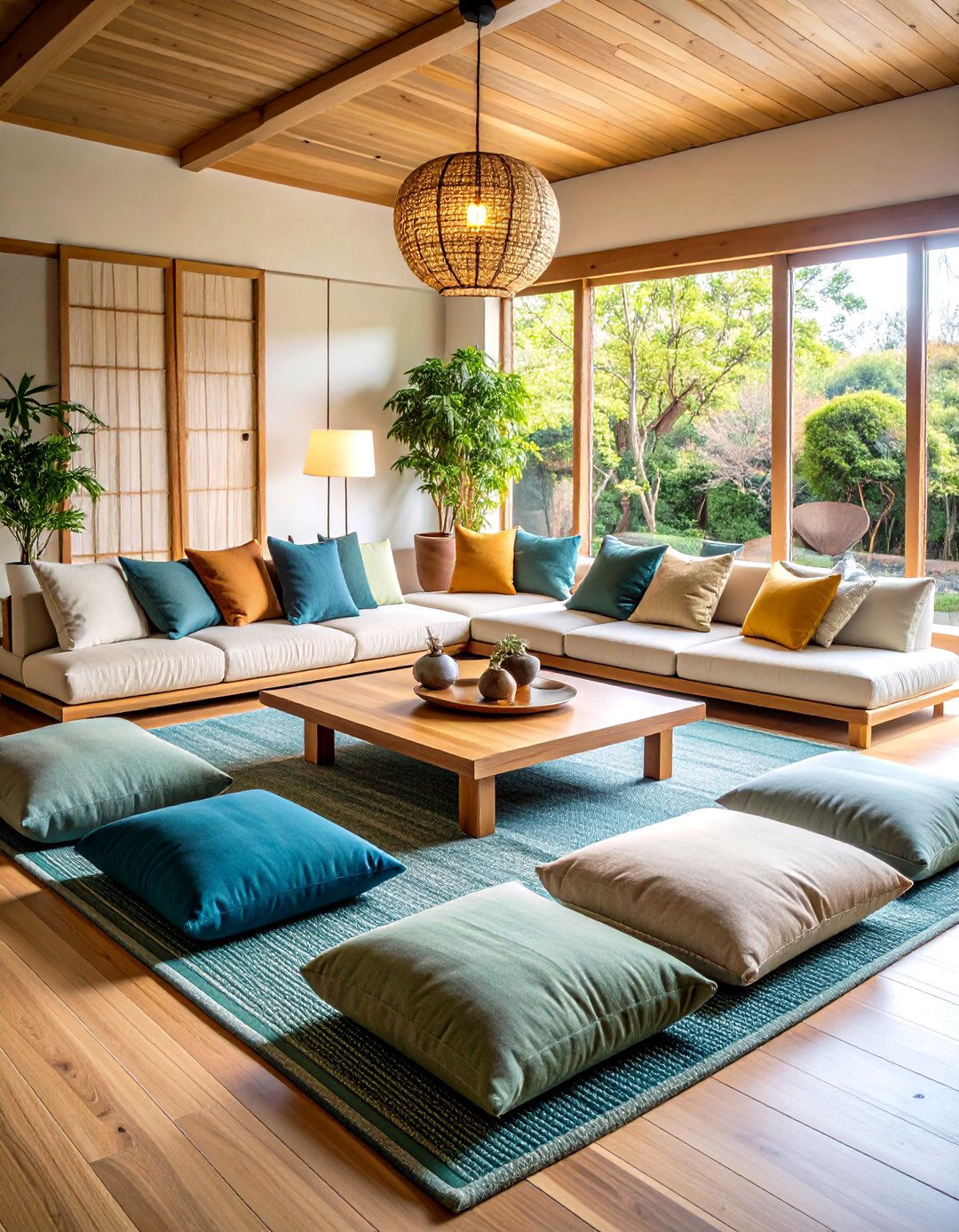
Low-profile seating arrangements with floor cushions, Japanese-inspired zabuton, or Scandinavian-style poufs around central coffee tables encourage intimacy and conversation. This seating style maintains unobtrusive visual profiles while supporting flexible room arrangements. Choose cushions in natural fabrics like linen or cotton in neutral tones that complement the overall palette. Floor seating supports the Japanese cultural element while providing casual, comfortable gathering spaces. These arrangements work particularly well for meditation, reading, or informal entertaining. The low height creates open sight lines and emphasizes horizontal planes that make rooms feel larger. This approach also supports minimalist principles by reducing furniture volume while maintaining comfort and functionality essential to livable spaces.
16. Japandi Living Room Live Edge Furniture

Live edge organic shaped furniture fits perfectly with Japandi style, made to last using high-quality sustainably sourced materials like oak. These pieces celebrate the natural beauty and imperfection of wood while providing functional surfaces and storage. Live edge tables, benches, or shelving units bring organic forms that contrast beautifully with geometric elements while maintaining material authenticity. The irregular edges and natural grain patterns add visual interest without overwhelming minimalist aesthetics. These pieces often become conversation starters while supporting sustainable practices through responsible material sourcing. The craftsmanship required for live edge pieces aligns with Japandi values of quality and longevity, creating furniture that improves with age and use.
17. Japandi Living Room Asymmetrical Design Elements
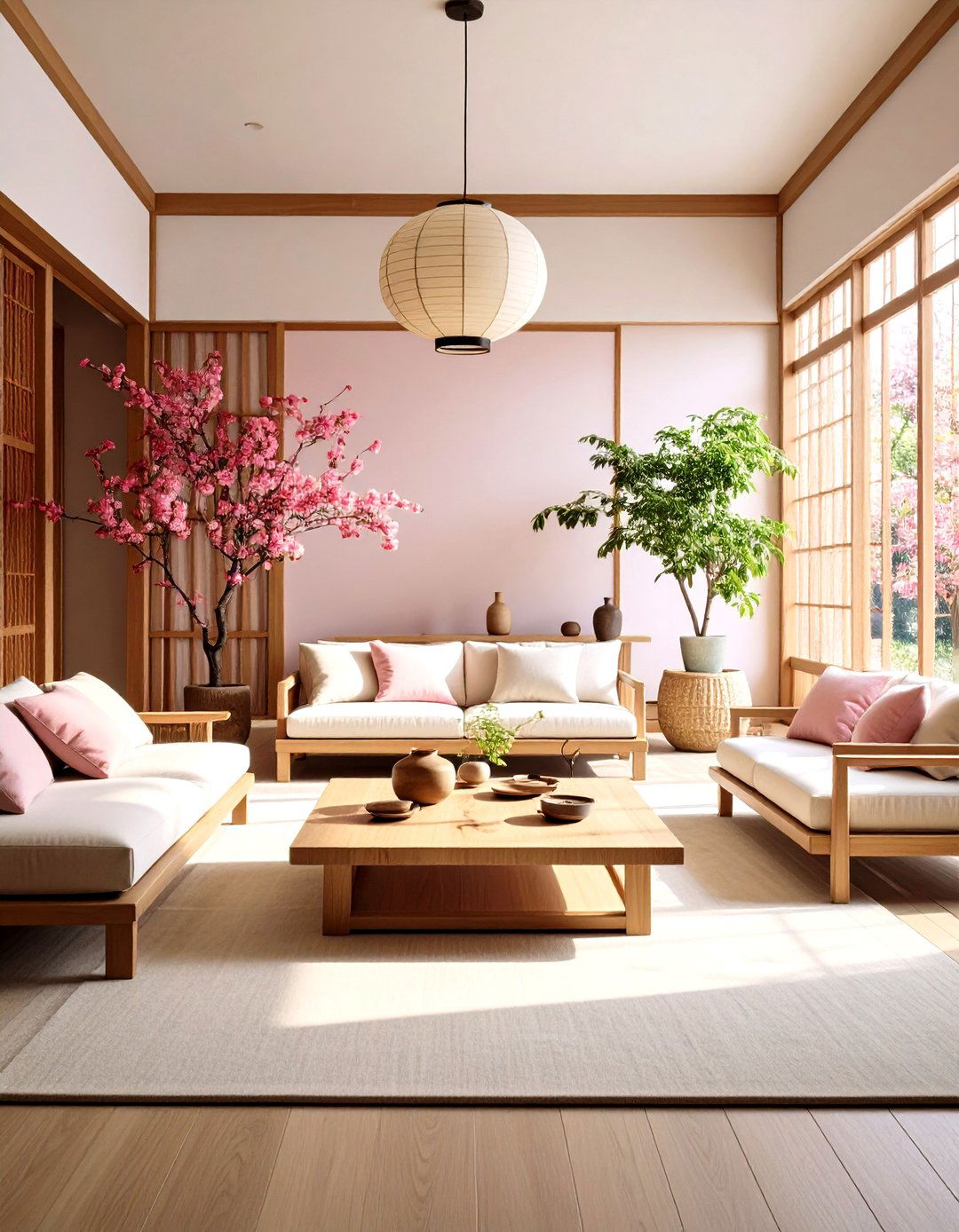
Symmetry is not a priority in Japandi interiors, allowing for organic arrangement of décor and furniture pieces to create more natural, flowing spaces. This approach prevents rooms from feeling too rigid or formal while maintaining overall balance through careful composition. Consider off-center furniture groupings, asymmetrical artwork arrangements, or varied height accessories that create visual movement. The key is achieving harmony through proportion and material relationships rather than mirror-image placement. This organic approach reflects natural patterns and supports the wabi-sabi appreciation for imperfection. Asymmetrical elements add personality and prevent spaces from feeling sterile while maintaining the thoughtful, intentional quality that defines successful Japandi design.
18. Japandi Living Room Indoor Plant Integration

Plants are crucial elements in Japandi design, adding natural, organic touches to spaces while connecting interiors with nature and providing air purification benefits. Choose easy-care varieties like snake plants, succulents, or money plants that thrive in indoor conditions. Strategic placement enhances the calming aura while adding pops of life and texture to neutral palettes. Consider plants in terracotta pots or bamboo planters that align with natural material preferences. Large floor plants can serve as living sculptures, while smaller specimens work well on tables or shelves. The greenery provides the only necessary color accent in otherwise neutral schemes while supporting the biophilic design principles central to both Japanese and Scandinavian traditions.
19. Japandi Living Room Curved Furniture Pieces
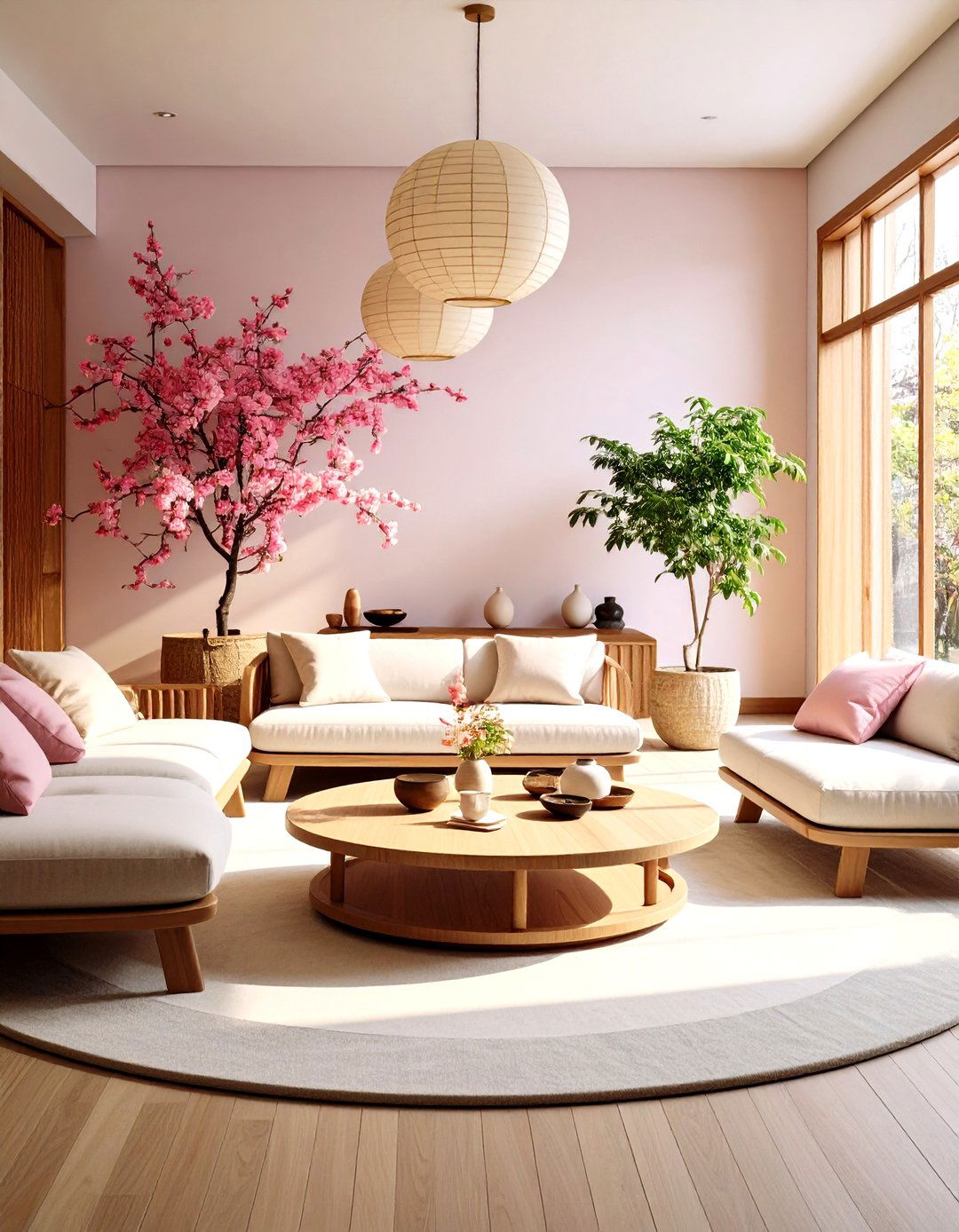
Rounded furniture pieces like curved sofas or circular coffee tables soften sharp edges in Japandi living rooms while creating cozy atmospheres through organic forms. These pieces provide counterpoints to linear elements while maintaining the clean aesthetic essential to the style. Curved pieces feel more approachable and comfortable while supporting conversation and social interaction. Choose furniture with gentle curves rather than dramatic sculptural forms to maintain the understated elegance. Curved elements can include arched floor lamps, round side tables, or barrel chairs that add softness without overwhelming the space. The organic shapes reflect natural forms while providing visual relief from predominantly geometric compositions, creating more inviting and livable spaces.
20. Japandi Living Room Layered Textile Arrangements
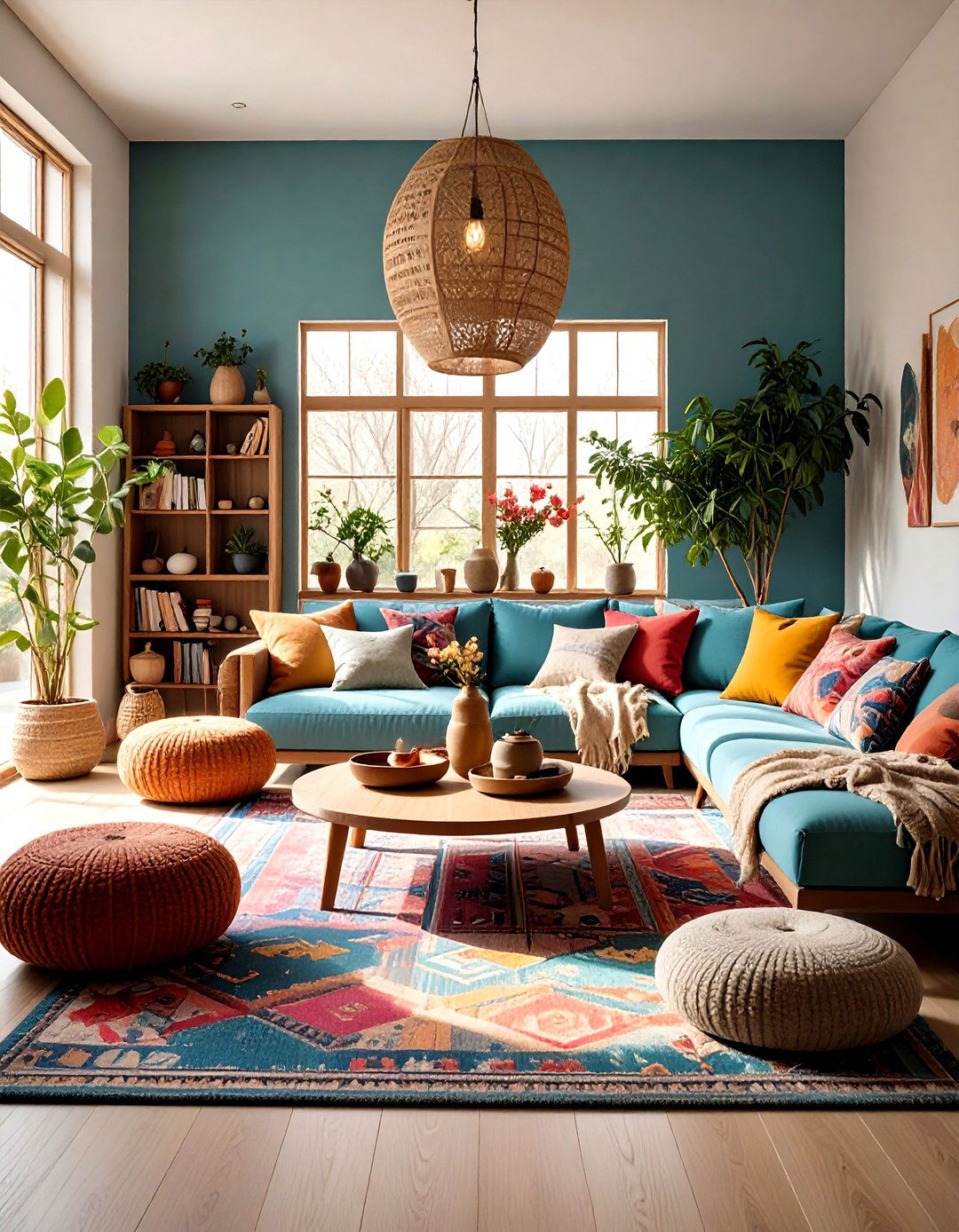
Layered textiles including handwoven rugs, throws, and cushions create warmth and invite relaxation while adding texture without cluttering spaces. Combine different natural materials and weaves in complementary neutral tones to add depth and comfort. Consider wool rugs layered with cotton throws, linen cushions paired with jute ottomans, or bamboo silk accents mixed with rougher textures. The layering should feel intentional rather than random, with each textile contributing to the overall harmony. These soft elements provide the comfort and coziness associated with Scandinavian hygge while maintaining the refined simplicity of Japanese minimalism. The natural fibers age beautifully, developing character over time that supports the wabi-sabi appreciation for imperfection and authenticity.
Conclusion:
Creating Japandi living rooms involves blending minimalist Japanese principles with Scandinavian warmth, prioritizing simplicity, quality craftsmanship, and deep connections to nature. These twenty ideas demonstrate how natural materials, neutral colors, and thoughtful furniture choices create balanced, harmonious environments that foster well-being. Each element should be chosen for both aesthetic appeal and functional value, ensuring spaces remain beautiful and practical. The goal is creating cohesive environments that support mindful living while celebrating the best aspects of both design traditions through careful attention to detail and purposeful curation.



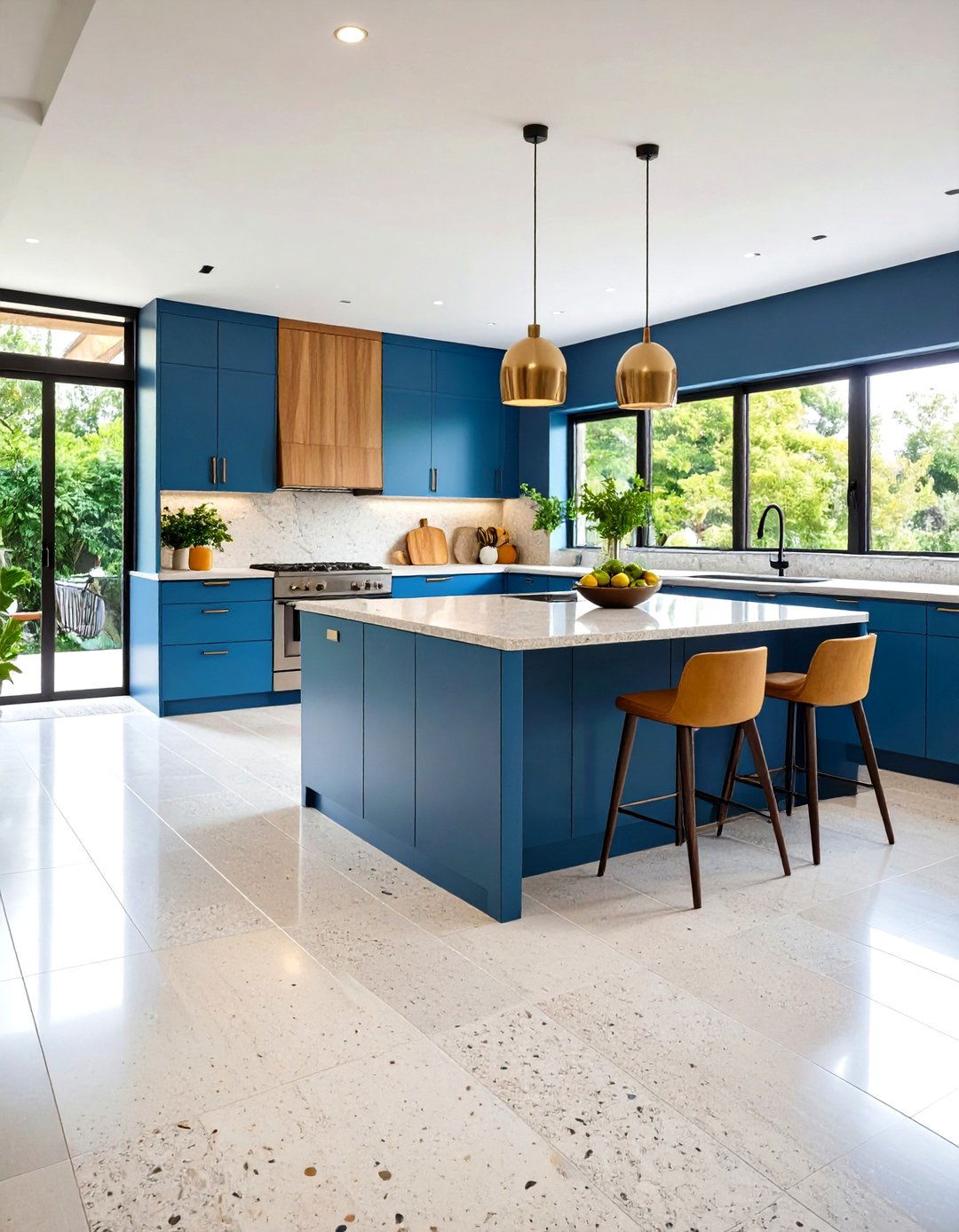
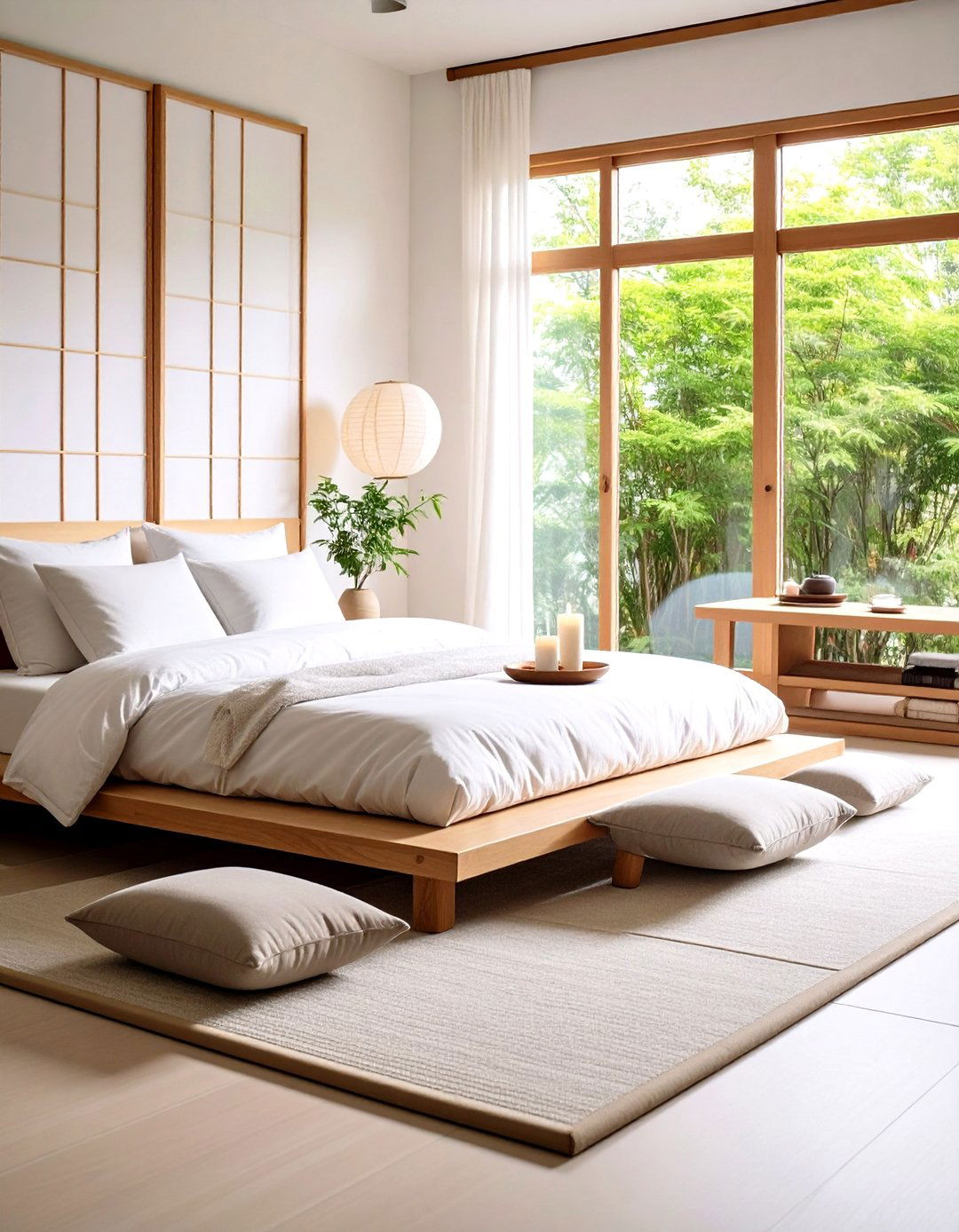
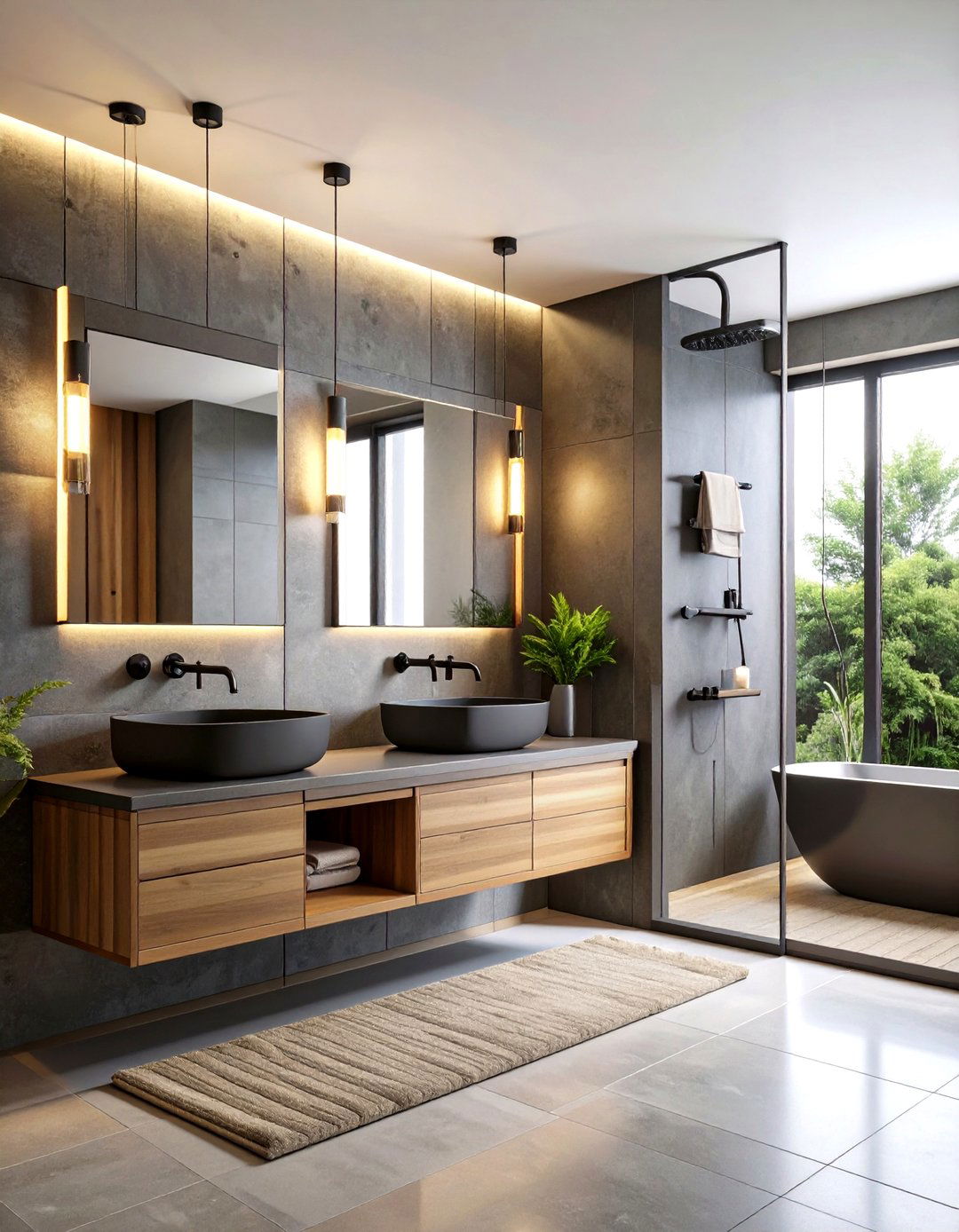
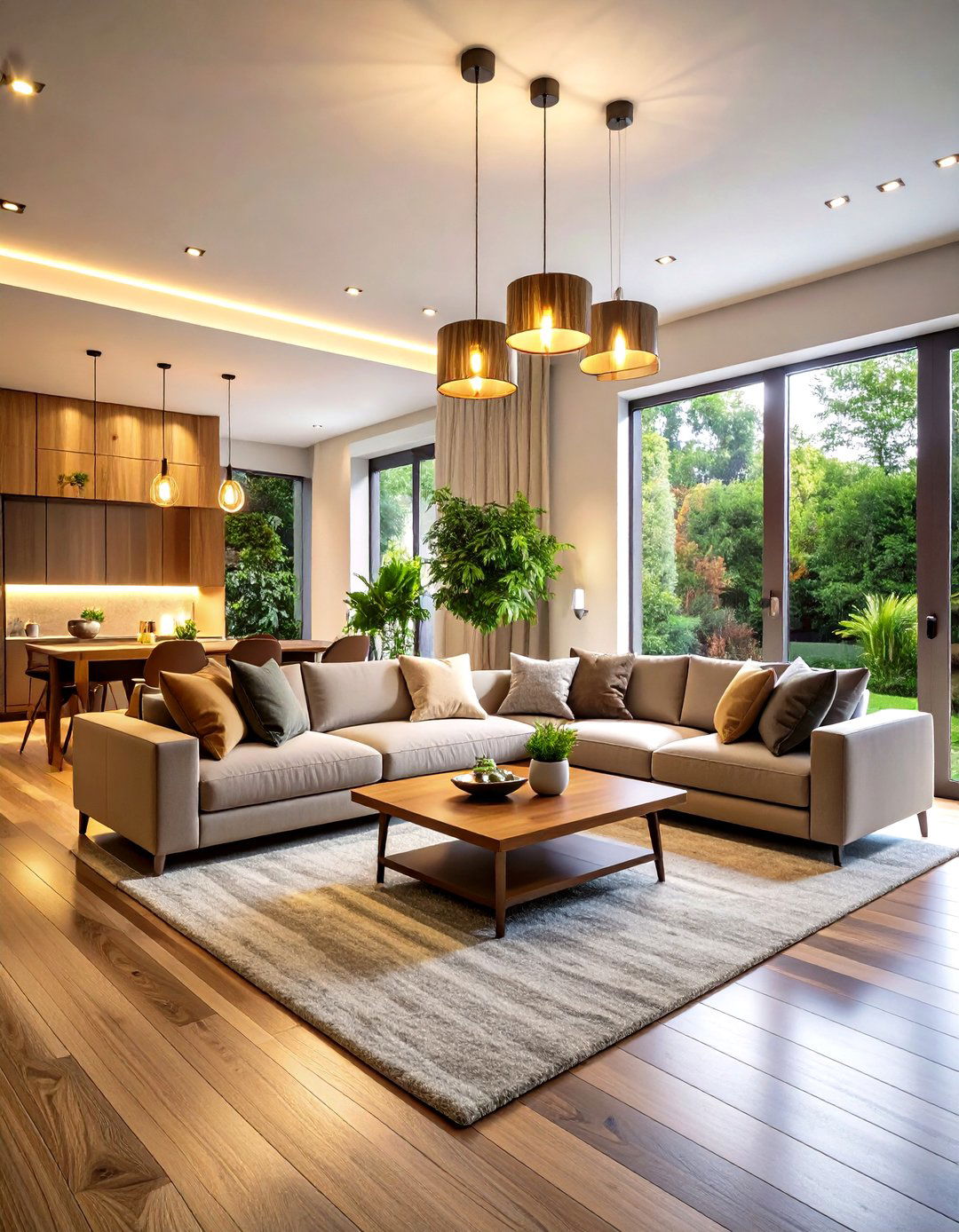
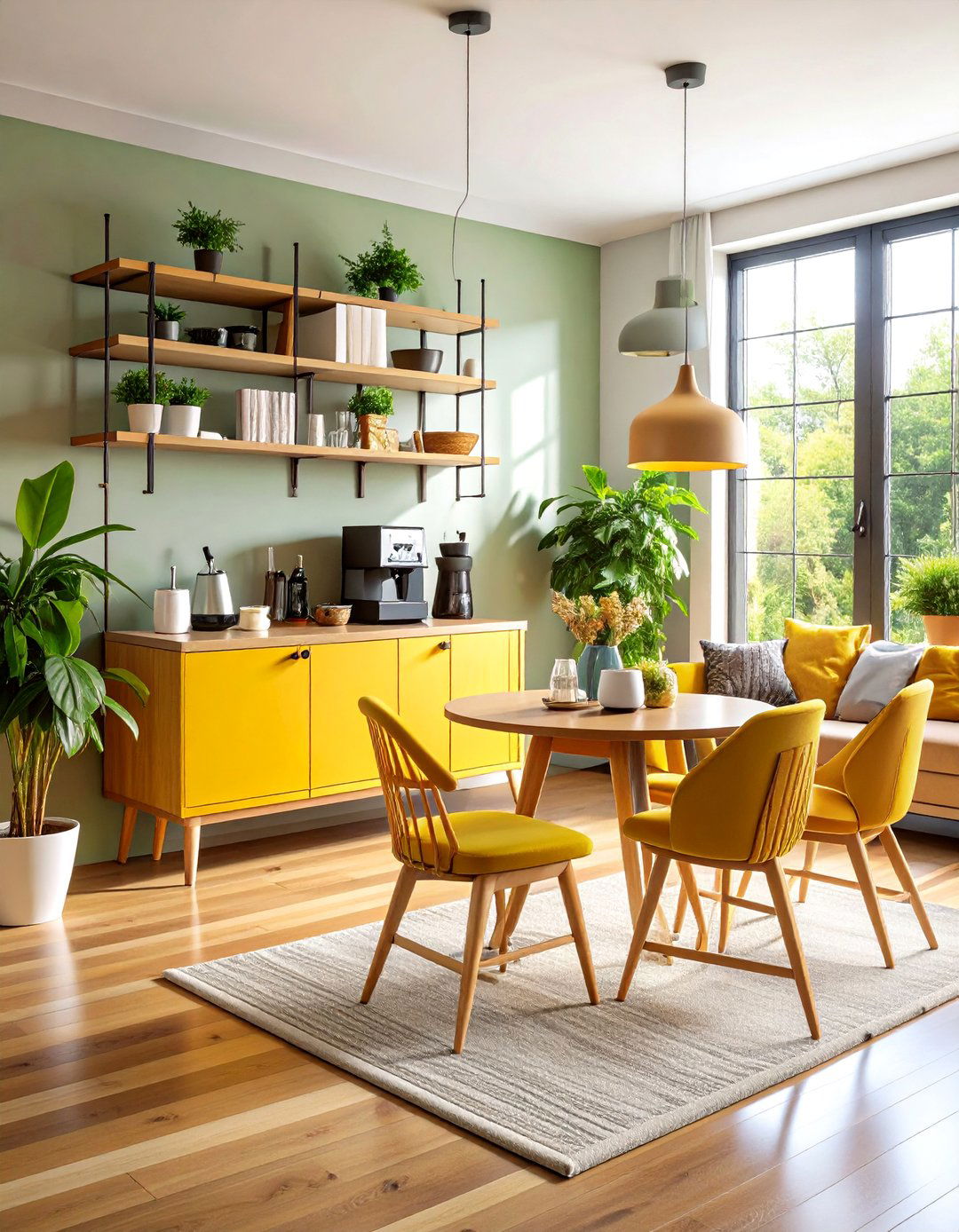
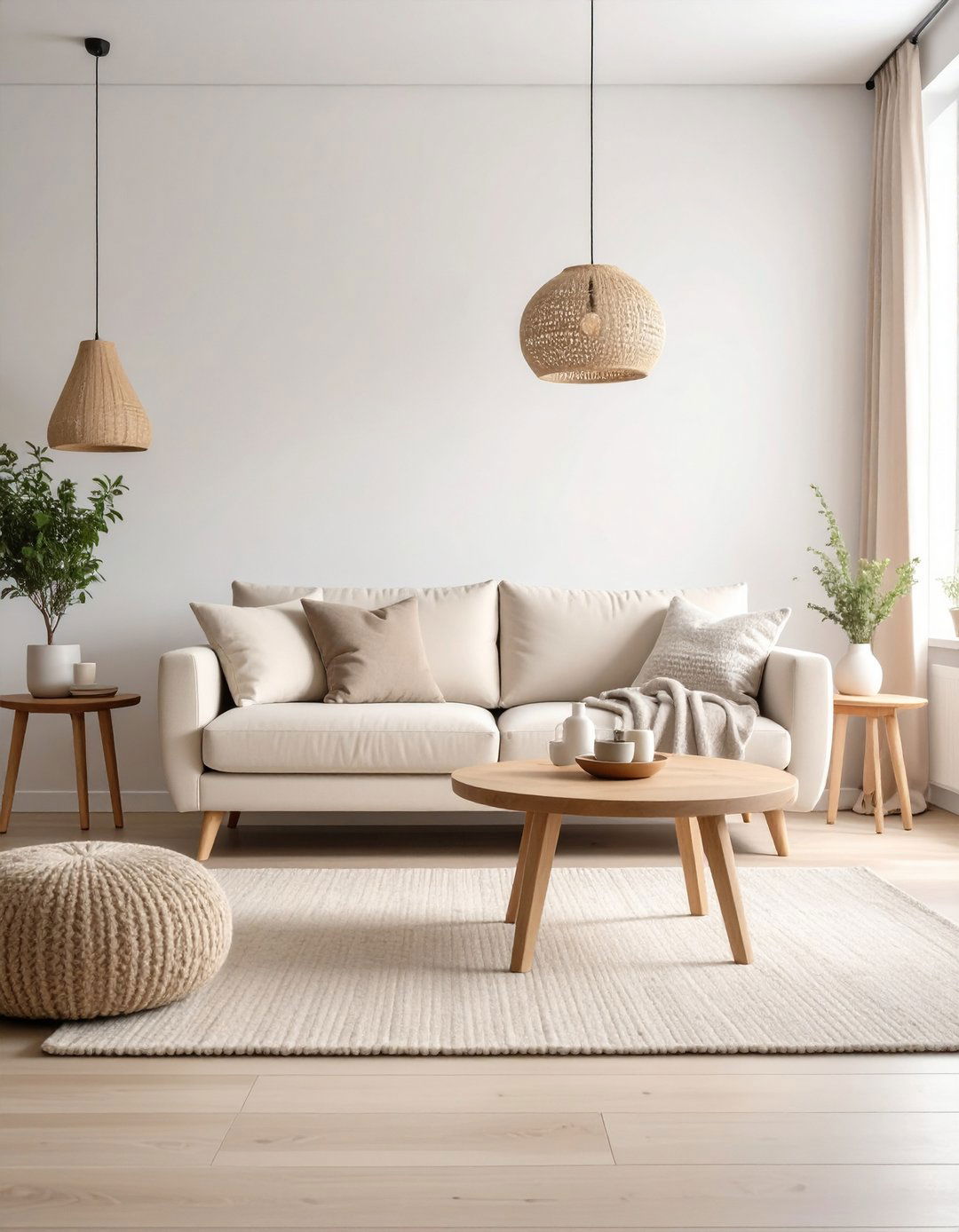



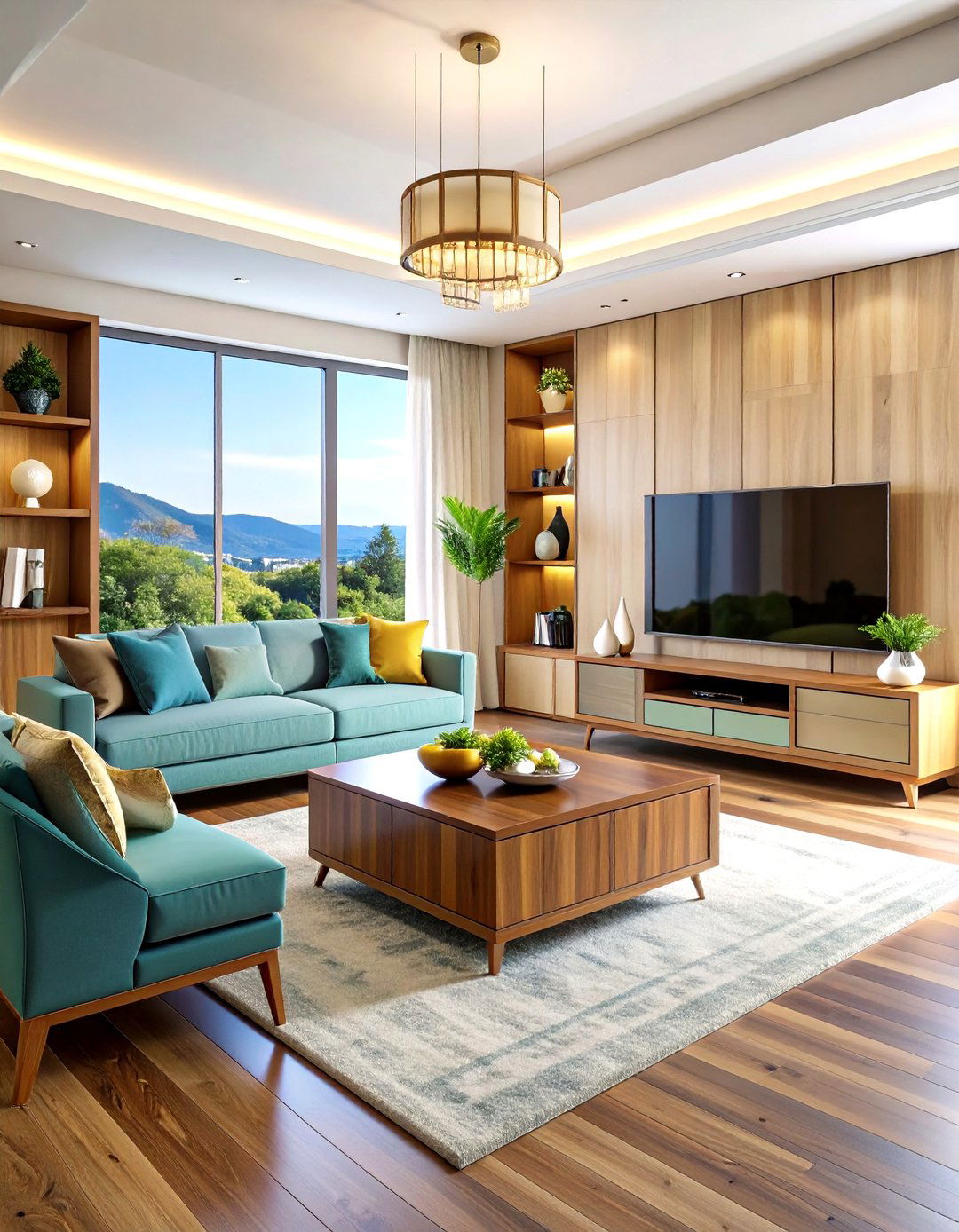
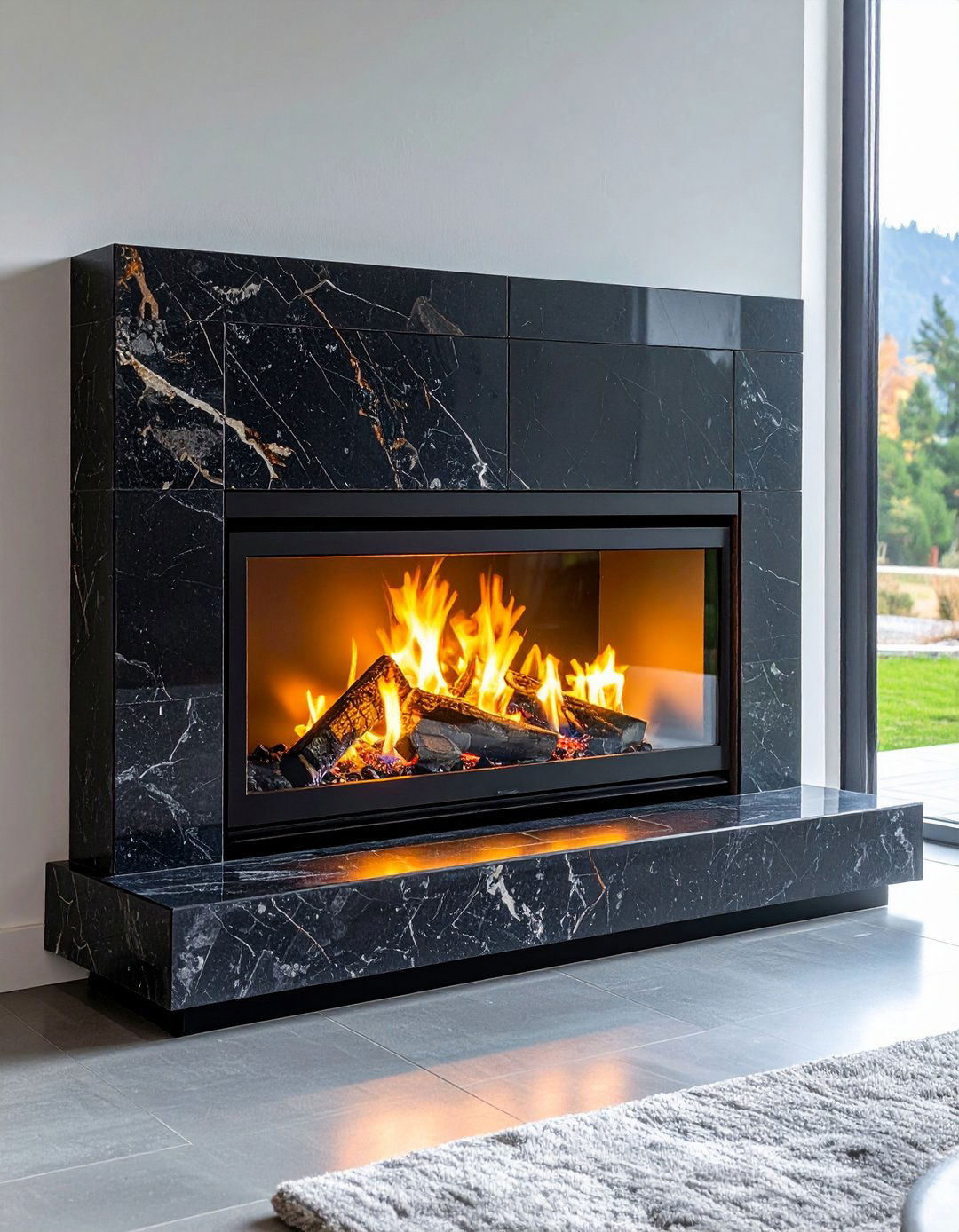
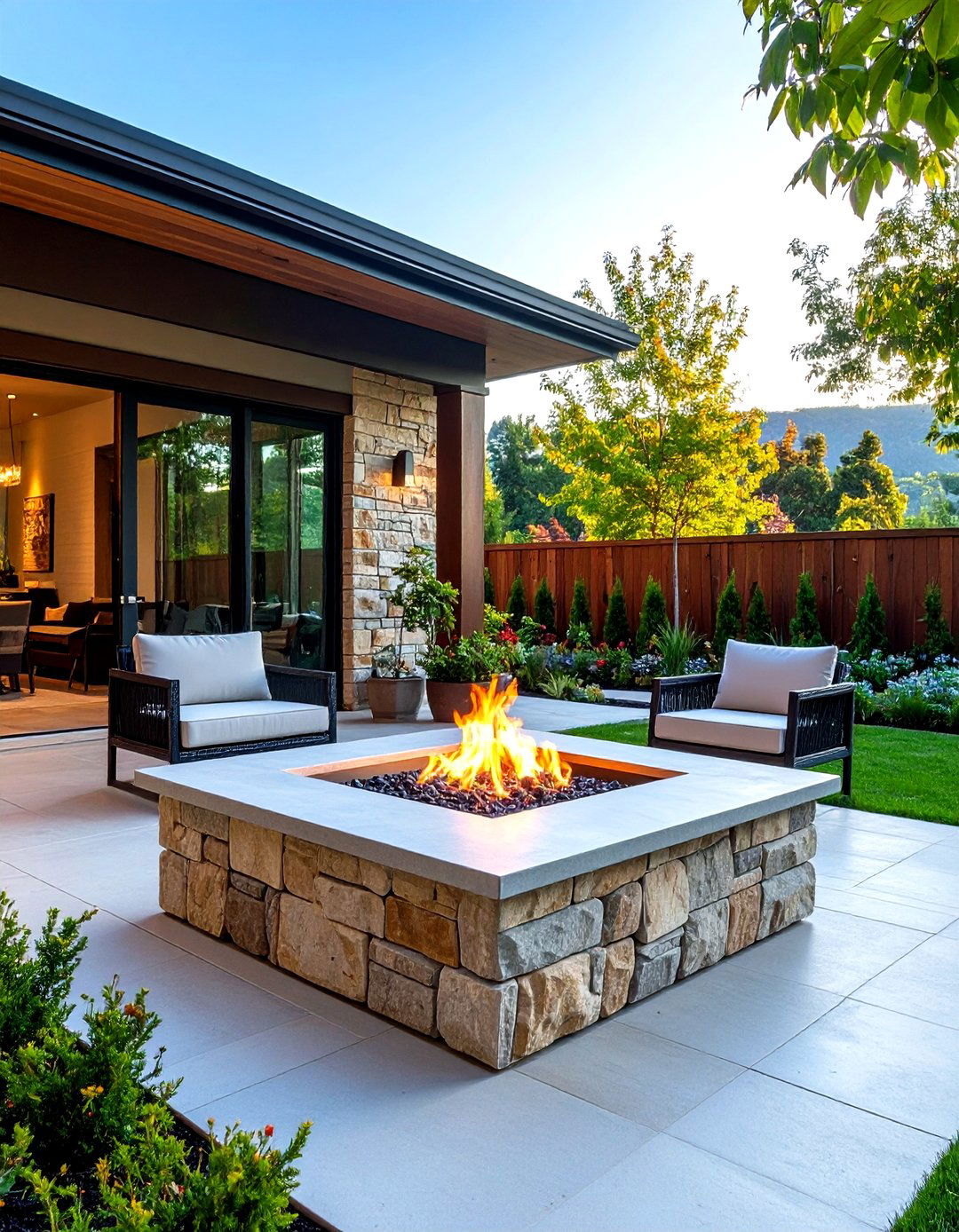
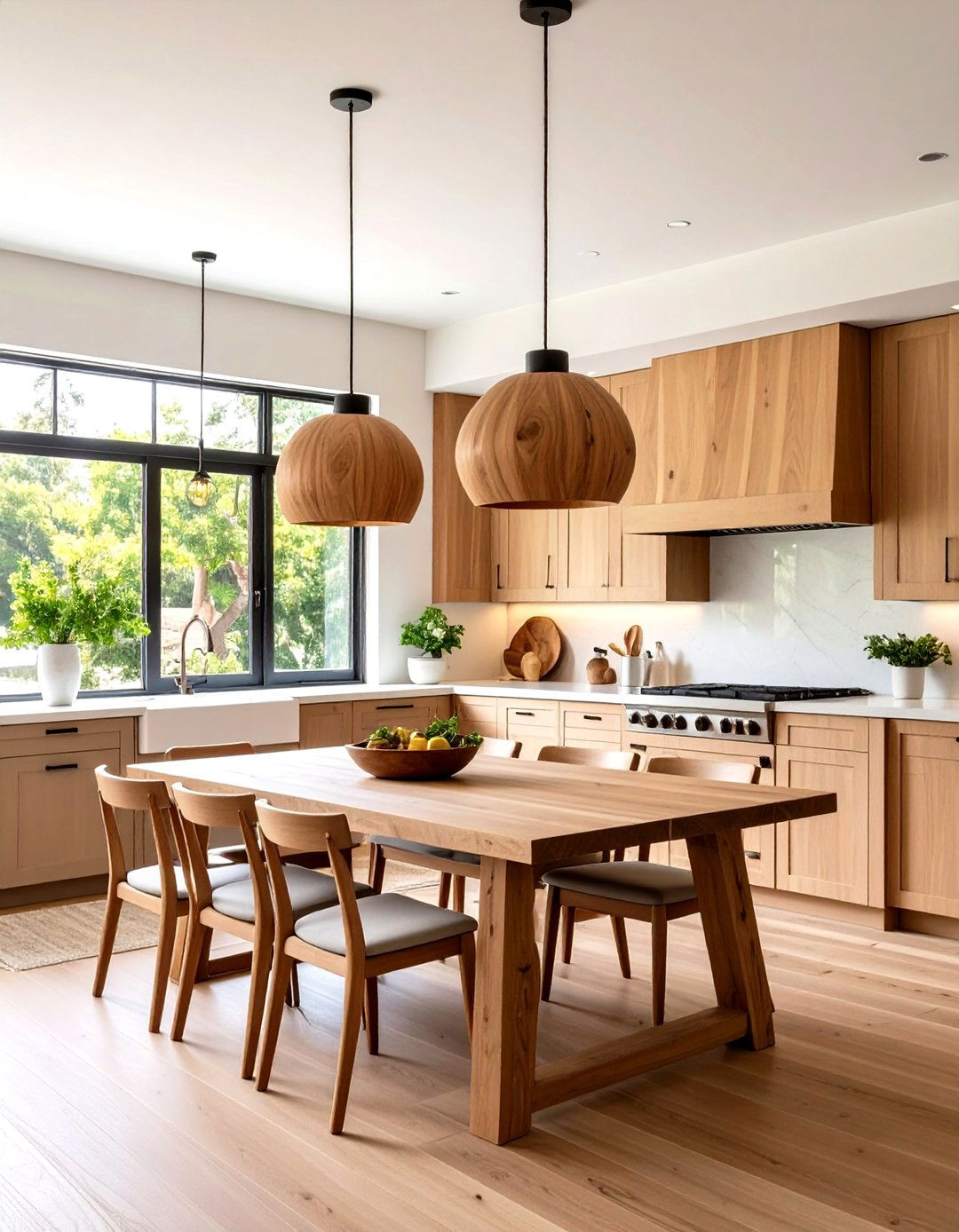
Leave a Reply